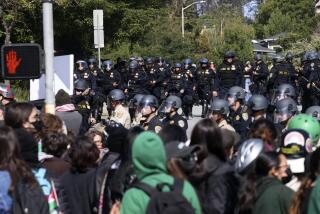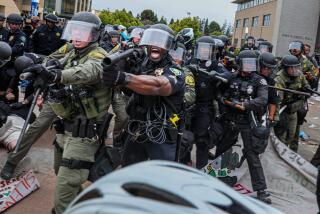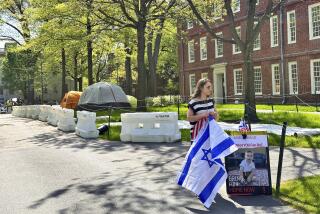Hong Kong protesters stay in streets, but schools reopen
- Share via
Reporting from Hong Kong — Student leaders urged Hong Kong democracy demonstrators to hold their ground Sunday night as preliminary negotiations ensued between protest leaders and government officials.
Tension ebbed and flowed in the semiautonomous Chinese territory throughout the day and night. A sense of foreboding was thick early Sunday as university administrators and other high-profile figures urged protesters to leave the streets for their own safety. About 5 p.m. it appeared some students were ready to give up some sit-in sites, but protest leaders quickly said they did not support any retreat.
Despite what had initially seemed like an ultimatum from Hong Kong Chief Executive Leung Chun-ying that protesters clear public roads by Monday morning, demonstrators held on to their encampments in the Mong Kok neighborhood and in the key government district of Admiralty.
Secondary schools that had been closed by the protest last week were reopened Monday, however, and protesters were not attempting to block civil servants from government headquarters.
On Sunday night, addressing a lively crowd of at least 10,000 near government headquarters, Hong Kong Federation of Students leader Alex Chow told demonstrators to hang in to preserve their leverage.
“We are issuing a warning to government: ‘If you trample on us again, we will not let it stand,’” Chow said.
After 10 p.m., a giant, newly constructed sculpture of a man holding a yellow umbrella, the symbol of the movement, was rolled into Admiralty on a dolly.
As midnight approached, the atmosphere around the chief executive’s headquarters was calm. Officers were in their normal blue shirt sleeves, not riot gear. Several small clutches of protesters stood chatting with a few officers about issues ranging from taxes to protest methods.
Leung took to the airwaves Saturday evening to call on protesters to disperse so that civil servants could return to work Monday morning and schools could reopen.
Peter Mathieson, president and vice chancellor of the University of Hong Kong, was joined Sunday in a call for demonstrators to declare an interim victory and initiate a strategic retreat. Former Chief Justice Andrew Li said demonstrators were risking a “misfire.” A leader of the city’s Executive Council, Lam Woon-kwong, also called for demonstrators to retreat.
But Willy Lam, a political analyst and professor at the Chinese University of Hong Kong, said the student leaders feared that if they dispersed now, they would have little to show after a weeklong student strike followed by eight days of mass street protests that have captured the world’s attention.
Hong Kong, a former British territory, returned to Chinese sovereignty in 1997 under an arrangement known as “one country, two systems.” The region of 7 million was supposed to enjoy a high degree of autonomy for 50 years, with the exception of matters such as foreign affairs and national defense.
Demonstrators have been angered by Beijing-issued guidelines for the territory’s 2017 election for chief executive. The rules would allow Hong Kong’s 5 million eligible voters to cast ballots for the first time for chief executive, but would require that candidates pass muster with a screening committee partial to Beijing. Protesters say that amounts to “fake democracy.”
Students have called for Leung to step down and for negotiations over rescinding the framework issued by Beijing.
But with incidents of violent confrontation continuing for a third day Sunday between the demonstrators and foes of the protests, pressure had been building for some kind of compromise solution.
During predawn scuffles Sunday in the Mong Kok neighborhood where protesters have been staging a sit-in for days, police with shields and batons briefly used pepper spray as crowds pushed and surged in narrow streets packed with people.
At a news conference Sunday afternoon, police said they had arrested 30 people in recent days for offenses including possession of weapons, sexual assault and fighting.
As many as 10 journalists were reported to have been injured, police spokesman Steve Hui said. He said 27 police officers have incurred chest, back, head and limb injuries.
Law is a special correspondent. Times staff writer David Pierson contributed to this report.
Follow @JulieMakLAT for news from China
More to Read
Sign up for Essential California
The most important California stories and recommendations in your inbox every morning.
You may occasionally receive promotional content from the Los Angeles Times.











